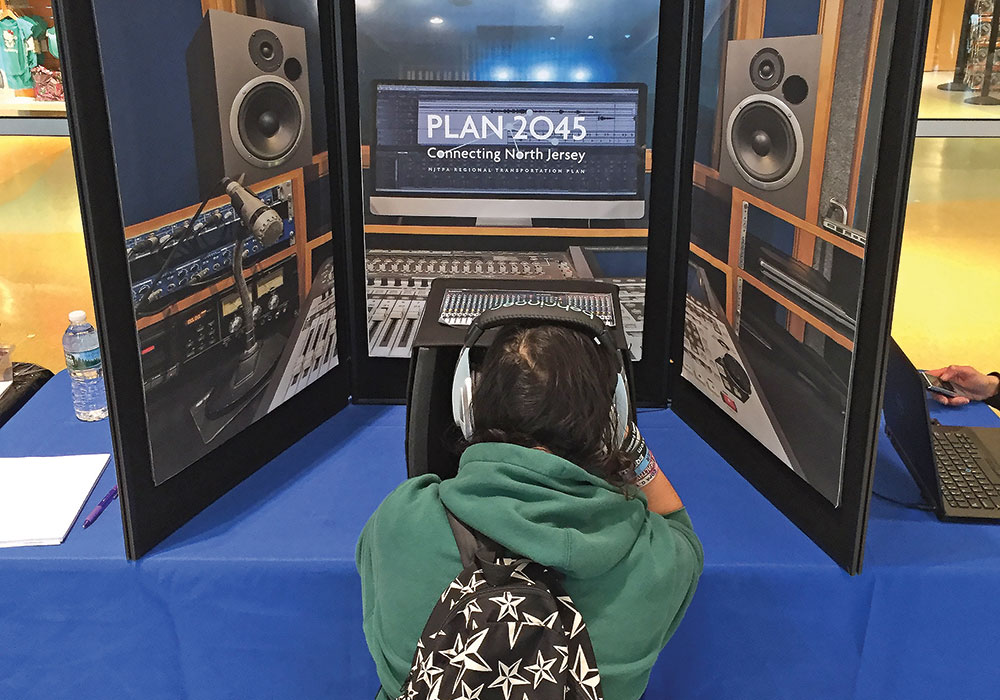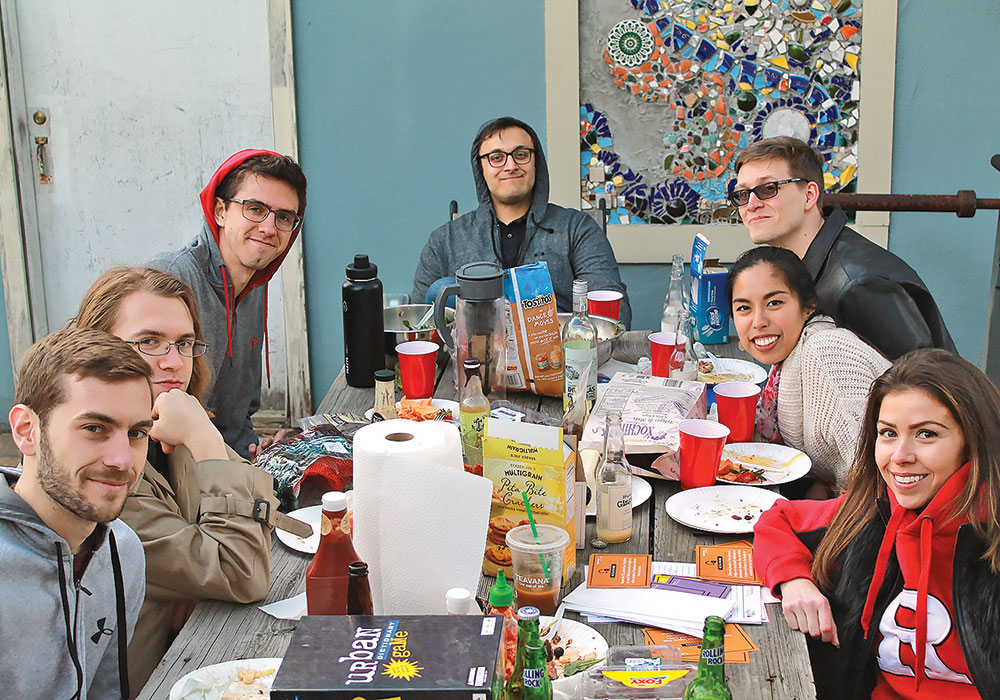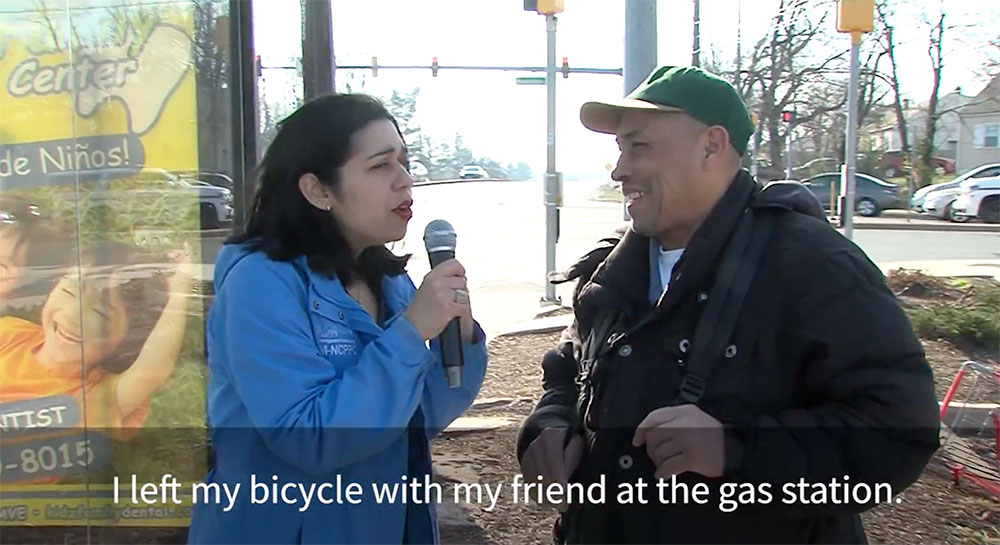Planning March 2019
6 Tips for Inclusive Public Meetings

The North Jersey Transportation Planning Authority's Plan 2045 interactive "radio station" booth gave 200 kids and teens a chance to talk about transportation's future. Photo courtesy North Jersey Transportation Planning Authority.
By Jeffrey Spivak
Let's be honest. Public meetings can be a disappointment. Most are underattended and run according to a formula that hasn't changed much over the years: They are usually held on a weekday evening, with a fixed and rigid agenda. Experts make lengthy presentations filled with planning jargon and legalese, and limited time is slotted for public input. It's no wonder they don't attract much of an audience beyond the usual suspects, complainers, and watchdogs.
"Historically, that process has not adequately represented the population," says Nate Baker, AICP, an associate with North Carolina-based Clarion Associates who specializes in helping communities craft comprehensive plans.
But as cities seek to become more equitable and inclusive, that approach is no longer cutting it in many communities, especially with groups that don't traditionally attend public planning meetings — non-English speakers, young people, parents with children, seniors, low-income residents.
"This has become a bigger issue just in the past few years — how to be more inclusive. Planners and project teams are waking up to the fact that all voices matter," says Amelia Shaw, executive manager of the International Association for Public Participation USA, which provides training on public engagement best practices.
New strategies
Some planners and communities are trying to reshape the engagement model, taking outreach in new directions and using innovative approaches, platforms, and events, all with a focus on more diverse participation. From their successful strategies, here are six tips you can use to engage some typically hard-to-reach audiences in your community.
1. Build relationships with key leaders and organizations.
One sure way to irritate the public is by making key decisions before they have been invited or allowed into the conversation. Connecting and brainstorming early on with important community stakeholders can help open doors with reticent groups and build trust at the onset.
This is especially true when planners are trying to work with non-English-speaking audiences. Culturally diverse groups, especially recent immigrants, rely on very specific community organizations to help them navigate the English-speaking world, including social service agencies, churches, and schools.
Planners hoping to engage such audiences should reach out initially to these trusted community organizations and explain the goals — and potential benefits — of the current engagement effort. If those organizations promote your planning event, non-English-speakers and immigrants are more likely to attend.
"If you post a message on Facebook, you might not have a lot of immigrants showing up," says Hanna Stelmakhovych, a public engagement program coordinator for the Institute for Local Government, which trains communities in California on public engagement best practices. "You have to know the groups they connect with."
Courtney Breese, managing director of the National Coalition for Dialogue and Deliberation, a Pennsylvania-based umbrella group of public engagement practitioners, adds: "This might take a little more time on the front end, but it can save a lot of pain on the back end."
2. Meet people where they are.

Samsung employees give feedback to Austin transportation planners, who came to their workplace. Photo courtesy City of Austin.
Asking groups to come to city hall or other government buildings can be inconvenient and, in some cases, intimidating for them. Instead, set up gatherings in places directly related to the groups you're targeting. Pop-up events in nontraditional spaces are an increasingly popular approach. For Austin, Texas's recently completed Strategic Mobility Plan, the engagement outreach included an obvious but sometimes forgotten group among hard-to-reach audiences: busy people with jobs. To reach them, planners hooked up with large employers, arranging focus groups, distributing surveys, and setting up tables in cafeterias at businesses such as electronics giant Samsung, the local electric utility, and an Alamo Drafthouse Cinema, among others. It all helped the outreach effort attain demographic samples that mirrored the city's population.
"We were able to reach more people than we would otherwise," says Liane Miller, AICP, the Austin transportation department's project manager for the plan. She presented the effort at an APA NPC 18 session last spring (right).
Eugene, Oregon, started an update of its Parks and Recreation Systems Plan in 2015, and decided to focus outreach efforts on the city's Latino community. The team fanned out at five different Latino community events to gather feedback on park designs and amenities. They attended an outdoor festival, showed up at an English-language literacy program, and set up a table outside the entrance to a Latino supermarket. What the park planners heard — the desire for more picnic shelters and barbeque grills for family gatherings, more soccer goals, and bilingual signage, among other things — was incorporated into the final plan approved in 2017.
"We took a lot of time to prepare and even train staff for this engagement," says Lorna Flormoe, an equity and access planner for the city. "The lesson is, make sure you go where the people are. Don't wait for them to come to you."
3. Know your target audience.

Set the Table parties reached a group that often avoids traditional meetings. Photo courtesy North Jersey Transportation Planning Authority.
To connect with particular demographic groups, have an engagement plan specifically tailored to them.
When the North Jersey Transportation Planning Authority set out in 2017 to develop its next 30-year transportation plan for northern New Jersey, it identified segments of the population it especially wanted feedback from. One group was millennials — who would likely be using the transportation system in 30 years.
But planners knew millennials don't tend to show up at public meetings. So they asked them to host their own meetings, which they could conduct in their favorite setting.
In a program called "Set the Table," the authority recruited (and paid) people to invite 10 friends to a dinner or a gathering at a coffee house or restaurant. There, the host pulled out an authority-provided pizza box that included paper, pens, snacks — and packets of discussion cards. The cards sparked conversations about how the participants get around town now and what they'd like to see in the future. At the end, the host bundled up the cards and returned the "meeting in a box" to the authority.
"It didn't look anything like something from a government agency," says Ted Ritter, who spearheaded that engagement effort as a special projects manager with the authority. "It was a hit."
Similarly, when the Columbus, Ohio, office of the planning firm OHM Advisors was hired by the Dayton suburb of West Carrollton for a downtown corridor study, planners wanted to gather opinions from a wide demographic. To especially reach busy moms with children, OHM in 2017 held a free ice cream social in a vacant downtown storefront. Around 200 people attended, and the moms tended to linger longer to complete planners' questionnaires because their kids didn't want to leave.
"It got town leaders excited because so many people showed up when they were used to no one showing up at meetings," says Jason Sudy, then a principal with OHM Advisors and now national lead of transportation technology planning for HDR Inc.
4. Make it fun.
Some people blame low public meeting attendance on the stale, boring format. But it doesn't have to be that way. Some planners have employed unusual events and technology tools to draw participants in and start off the feedback process with a good vibe.
In Ohio, OHM Advisors came to the Columbus suburb of Newark to develop a citywide Vision Plan in 2017.
To solicit millennials' feedback on the plan's downtown chapter, planners organized a different type of engagement draw: They held a free concert.
The local owner of a restored historic concert hall in the downtown volunteered to bring in a touring indie-soul band called The Rad Trads. A crowd of some 300 showed up.
Before the show, planners set up booths for concertgoers to be interviewed, complete surveys, and offer their ideas in a comfortable atmosphere, complete with cash bar.
"I can't think of any millennials who would show up for a public meeting at the local senior center," says Erin Moriarty, a planner who helped organize the concert event and who is now with ms consultants in Columbus.
Canada-based public-involvement software developer MetroQuest operates under the assumption that people are so time-sensitive today that they will only focus on an online survey for about five minutes. So the company turns the planning questionnaires into games.
In one, participants are shown visuals of community options and asked to vote on or rank their preferences.
In another, participants can build their own budget preference for, say, road improvements, by moving or rearranging coins representing different spending options (building something new or maintaining existing, for example).
"Short and fun are the two most important metrics in what ends up getting shared on social networks," says Dave Biggs, MetroQuest's chief engagement officer.
5. Eliminate barriers.


Scenes from Montgomery County, Maryland's commuter outreach YouTube video. Photos courtesy Montgomery County.
For people with jobs or for parents and caretakers, traditional public meetings can be extremely inconvenient. For others whose first language is not English or who don't want to share their opinions in front of a room of strangers, they can be intimidating. These are just some of the potential barriers that can prevent or discourage participation. Try to eliminate as many barriers as possible.
That might include providing child care or children's activities or even transportation to a meeting. Be sensitive to time constraints. Design meeting processes so input can be received in a variety of ways, such as breaking participants into smaller settings that allow anyone to speak, or providing opportunities to give feedback through technology with kiosks, tablets, paper surveys, or smartphones.
"The more you lower the barriers to participation, the more likely you are to engage people," says MetroQuest's Biggs.
In Montgomery County, Maryland, outside Washington, D.C., the planning board decided to develop a new transportation plan for the Veirs Mill road corridor, which stretches four miles across a community where more than half the residents speak a language other than English. Planners decided to engage those residents by meeting them on their daily commutes.
One morning in early 2018, planning board commissioner Natali Fani-Gonzalez, a few staffers, and a camera crew showed up at a bus stop to ask residents how they use the bus and what ideas they had to improve service. The planning crew spoke Spanish with the residents and continued the dialogue by riding with the commuters along the corridor.
The resulting video was posted on YouTube and shown to Fani-Gonzalez's fellow commissioners to help make the residents' case for better sidewalks and more crosswalks. The plan was approved in December.
"These were not people who would go to a planning meeting," says Fani- Gonzalez, who also runs her own public engagement consulting firm. "They have two or three jobs. They don't have the time. So we had to go to them."
6. Don't stop!
Finally, the engagement process should not end when a planning document is completed. One more lesson is to close the feedback loop by going back to targeted audiences and sharing the outcomes or recommendations they contributed to. Some planning agencies are beginning to develop programs for continuous engagement.
In Austin, the Strategic Mobility Plan — which is expected to be considered by the city council this spring — recommends an ongoing public engagement program. The intent is to keep the dialogue going with the public on occasional issues that arise or large-scale projects that get proposed.
"We just saw that almost everything we do requires some engagement, and we just can't do it once every five years or so," says Austin's Liana Miller.
Some communities are willing to budget extra money for public engagement knowing it will have long-lasting benefits beyond a single effort. Eugene's park planning engagement with Latinos, for example, continued after the system plan was approved, and it contributed to city voters passing a bond issue last spring that included park improvements.
Says Lorna Flormoe: "Now we have an ongoing relationship with the Latino community."
Jeffrey Spivak, a market research director in suburban Kansas City, Missouri, writes about real estate planning, development, and demographic trends.


